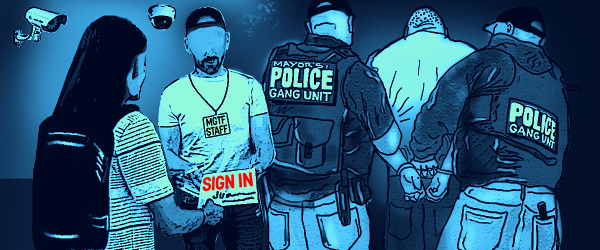
SAN JOSE, CA — In San Jose, there’s a challenge to the role of law enforcement in youth services and a push back against a further criminalization of Black and Raza youth.
The city has a nationally acclaimed Mayor’s Gang Task Force. It provides resources for youth services through community organizations, and gang suppression in gang hotspots through law enforcement. The direction comes from law enforcement and the entanglement of the two “sides” leaves youth who deserve services exposed and targeted.
Youth are classified through “risk measures” based on where they live, their contact with law enforcement, and impact of being incarcerated. None are measures of how to lift the opportunity and equality of the communities the youth live in, nor do they measure decarceration. These risk measures are defined and driven by law enforcement and the juvenile justice system.
What do police captains, the District Attorney and the Gang Investigation Unit have to do with youth services when their sole purpose is prosecution, gang intelligence, monitoring and arresting suspected gang members and associates?
Between 1980 and 2016, the arrest rate dropped 84 percent for juveniles according to a recent Public Policy Institute of California report. Yet despite the decrease, some cities and counties have committed tremendous amounts of resources to “lock ‘em up” approaches.
Gang Hotspots are synonymous with our barrios that have historically been impacted by poverty and inequality. Crime is only a result of poverty and inequality. Gang Hotspots are also synonymous with gang locations. While youth in these impoverished areas need services, the conflict lies with the fact that the City’s youth services are being driven by the same entities waiting in line to prosecute and incarcerate them.
Police document youth and adults as suspected gang members and associates when they live in these gang locations, even when they are never arrested, simply for associating with other suspected gang members and associates. Cultural and regional identifiers such as fashion and tattoos are also documented. Remove “gang” from the picture and these police stops are synonymous with racial profiling.
Santa Clara County prosecutors abuse gang “documentation” to convince juries to find our youth and adults guilty of gang enhancements even when gang documentation never resulted in an arrest or had anything to do with the alleged charges. Prosecutors often do this by abusing services that youth and adults may be receiving from the Task Force. For example, late night gyms are intended to provide a safe space for gang-impacted youth to participate in recreational activities while receiving services from community organizations. But instead, the District Attorney’s office uses participation in these centers to build their gang enhancement cases.
The City needs a model which can explore and invest in alternatives to incarceration directed by community organizations. True youth justice national leaders believe in rehabilitation, and we must remove law enforcement and prosecutors from youth services entirely.
